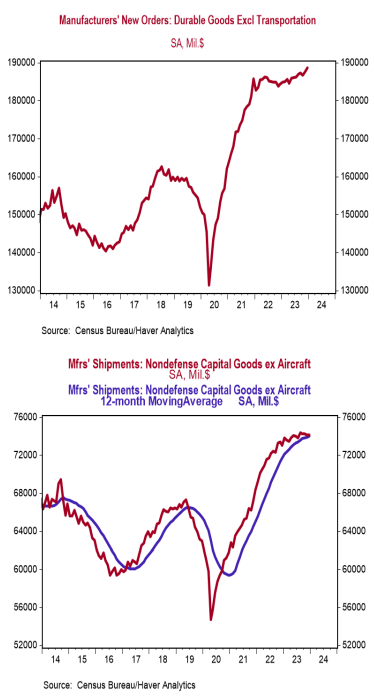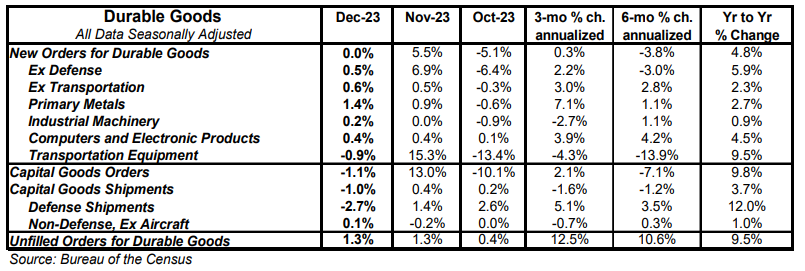- New orders for durable goods were unchanged in December (+0.1% including revisions to prior months), lagging the consensus expected +1.5%. Orders excluding transportation rose 0.6% (+0.7% including revisions), versus a consensus expected +0.2%. Orders are up 4.8% from a year ago, while orders excluding transportation have risen 2.3%.
- Rising orders across most major categories were offset by a steep drop in orders for defense capital goods in December.
- The government calculates business investment for GDP purposes by using shipments of non-defense capital goods excluding aircraft. That measure rose 0.1% in December and was up at a 0.1% annualized rate in Q4 versus the Q3 average.
- Unfilled orders rose 1.3% in December and are up 9.5% in the past year.
Implications: New orders for durable goods were unchanged in December following a surge in November. Looking at the details of the report, rising orders across most major categories – led by orders for primary metals (+1.4%), fabricated metal products (+0.9%), and electrical equipment (+1.8%) – were offset by a steep 14.5% drop for defense capital goods. Stripping out the volatile transportation category shows orders for durable goods up a healthy 0.6% in December versus a consensus expected gain of 0.2%. In the past year, orders for durable goods are up 4.8%, while orders excluding transportation are up a more modest 2.3%. Arguably the most important number in today’s report is core shipments – a key input for business investment in the calculation of GDP – which rose 0.1% in December. These shipments rose at just a 0.1% annualized rate in Q4 vs the Q3 average (for more information on today’s Q4 GDP report, click here). The growth of shipments has been slowing since the start of 2022, and we expect this trend will continue as the economy feels the lagged effects of the Federal Reserve’s actions to tighten monetary policy. A number of factors are likely to keep the path forward rocky as we move into 2024: restrictive monetary policy from the Federal Reserve, the tightening of lending standards following stress in the banking sector, and withdrawal symptoms following the COVID-era economic morphine that artificially boosted both consumer and business spending. In addition, the return toward services likely means goods-related activity will continue to soften in the year ahead, even as some durables that facilitate services remain healthy. In recent manufacturing news, the Richmond Fed index, a measure of mid-Atlantic factory activity, slipped to -15.0 in January from -11.0 in December. Meanwhile, the Kansas City Fed Index, a measure of factory sentiment in that region, fell to -9 in January from -1 in December. Together these indexes signal continued sluggishness in the factory sector. In employment news this morning, initial claims for jobless benefits rose 25,000 last week to 214,000. Continuing claims rose 27,000 to 1.833 million. These figures are consistent with continued job growth in January. We also got data on the M2 money supply this week which rose 0.5% in December but is down 2.3% from a year ago. Monetary policy operates with a lag, and we are likely to feel the negative economic effects of these declines in 2024





